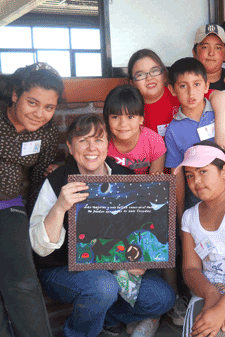
|
 |
Acompañamiento: A Story from Chile
Elena Huegel
The Spanish word acompañamiento and the core value mutuality made me think of Carolina Fernández, my former Sunday School student from Paraguay who is now coordinating a project called Landfillharmonic where young people are taught to make and play classical musical instruments (violins, cellos, and flutes) from garbage. Her life is a living example of acompañamiento. She spent New Year’s Eve with me at the Shalom Center retreat, where we lay on the look-out over the waterfall and watched the “natural fireworks” of shooting stars and moonrise. I asked her to share her vision and calling of mutuality or acompañamiento. This is how she answered.
“At camp we have a favorite dance called the Wee Waltz. I don’t know where it is from, exactly, but I guess from some European country. Whenever I think of my calling to walk alongside others, I think of this dance that I was taught at the Jack Norment Camp in Paraguay when I was a young child. I have used the same dance to teach the young musicians in our Landfillharmonic program about acompañamiento.”
At the beginning of the dance, we greet each other face to face. So also begin our relationships. We stretch out from our own space and hold hands. When the music starts, we must adjust our rhythm to that of the other person and we are aware that we are also coordinating with an entire community dancing around us. Sometimes we lead our partner and sometimes we follow. We struggle to adjust our individual rhythm to that of our partner as well as the whole community. At one point in the dance, we move into our partner’s space and dance from his or her place, but we are still ourselves and we have shared our own space, too. We respect each other’s space, but we also connect holding hands. We are anxious and nervous, trying not to step on each other, miss a beat, or forget the pattern. We laugh feeling a little silly. But everyone else laughs too. Everyone else makes mistakes and it is ok. We are vulnerable in our clumsy attempts toward gracefulness, reminding each other to not count “one, two, three” out loud.
In another part of the dance, we change partners. We must let go and adjust again, learning to be flexible and the pattern comes more easily. We change partners with more and more ease, until we return to our original partner and discover we have both learned. We dance better because we have been with others, and we have each grown in our individuality as well as flexibility. We celebrate our growing capacity, we stumble less, we are less tense and begin to enjoy the flow of the dance.
In acompañamiento there is a strong physical and spiritual sensation of being in the presence of another person. To walk alongside is not only an emotional or intellectual exercise. Acompañamiento is the experience of being formed and transformed by dancing with another person, within the circle of a community, to then take the beauty and grace of that dance to all the other spaces and times where we are called to be present. Acompañamiento mutuality is the way we let others know they do not dance alone and we are reminded that we, too, receive the gift of the presence of others.”

| 
| 


 
Elena Huegel serves with the Pentecostal Church of Chile (IPC). She serves as an environmental and Christian education specialist. Her appointment is made possible by your gifts to Disciples Mission Fund, Our Churches Wider Mission, and your special gifts.

| 
|






